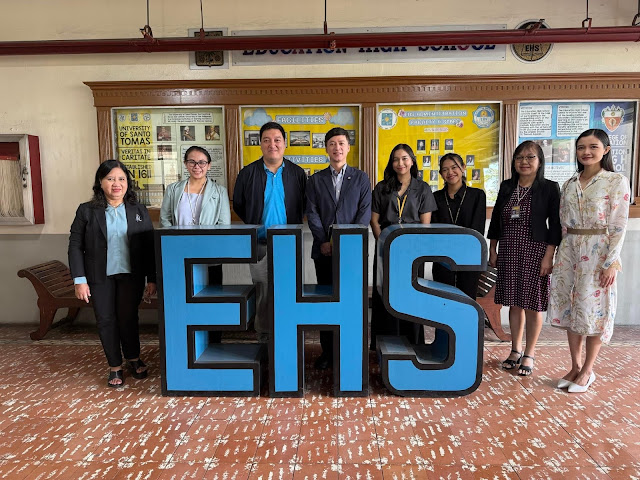EHS: Education High School
EHSEducation High School
The Education High School (EHS) is a separate institution from the UST High School. EHS was established to give quality Catholic education to those deserving students who cannot afford to pay the fees required by other schools. It also serves as the training ground for fourth year BSE students of the College of Education. This laboratory school was established during the time of Rector Magnificus Rev. Fr. Angel De Blas, O.P. through the help of the Dean of the College of Education, Rev. Fr. Aurelio Valbuena and Mrs. Caridad Z. Sevilla, the EHS principal and the different critic teachers of the College of Education. Classes commenced on August 1, 1950.
A number of faculty members from the College comprised the first set of critic teachers for the different subject areas in the EHS. They were: Dr. Mercedes G. Santamaria, Dr. Clemencia J. Colayco, Dr. Rosario D. Bondoc, Miss Concepcion Leonor, Mrs. Antonia P. Villanueva, Miss Consuel Perdices and Miss Nina Custodio.
The first regular teachers were Miss Concepcion Alba, Mrs. Salud P. Belmonte, Mrs. Salome Castillo, Miss Rosario Mauricio, Miss Lourdes Z. Sevilla and Miss Teresita R. Villamil.
There were 361 students in the first enrolment of the EHS. There were ten (10) sections in the first year, two (2) sections for the second year and two (2) sections for the second year and two (2) for the third year. Half of those sections were attended in the morning by girls, half in the afternoon by boys.
In order to give authentic religious and practical leadership training and to strengthen unity and cooperation among the students, religious and secular organizations were founded. Among them were Student Catholic Action Units for the boys and girls and the Knights of Jesus for the Boys. Mr. Arturo De Leon served as their Adviser. The Boy Scouts were adopted to give some training to male students.
Through the years, the EHS has been in the forefront of championing the cause of Catholic education in the Secondary School level. As the University of Santo Tomas enters its 405th Year, the EHS will continue to put premium on developing competence, commitment, and community involvement coupled with the core values of patriotism, respect, piety, responsibility, simplicity, honesty, integrity and justice among its students.
REV. FR. MAXIMO P. GATELA, O.P., PHL REGENT
 |
| Auditorium |
 |
| Computer room |
 |
| Library |
- The Education High School shall use a hybrid mode of delivery, combining the Enriched Virtual Mode (EVM) and Face-to-Face (F2F) as learning delivery modalities.
- 70% of classes will be delivered Face-to-Face and 30% will be delivered through EVM.
- For every grading period Week 1,2,4,5,7,8 & 9 will be onsite and week 3 & 6 will be online.
- All the major Examinations will be given onsite.
- There will be few asynchronous classes during Saturdays.
- Competency-based model is based on the broader concept of outcomes-based education (OBE), which starts with the desired competencies set in the curriculum map and moves to the learning experiences that should lead students to develop those competencies that will be evaluated during assessment. They follow the DepEd MELCS and for Grade 7 the set competencies in the Matatag Curriculum.
- Learner-centered curriculum design takes each individual's needs, interests, and goals into consideration.
- lt acknowledges that students are not uniform and adjust to those student needs.
- Learner-centered curriculum design is also part of peeragogy.
- UST Cloud Campus powered by Canva
All faculty members and PST's shall use this platform to have a single repository of all learning materials, for consistent access to students and for ease of monitoring user activity of both students and faculty
- Available video conferencing tools integrated in Blackboard
ZoomGoogle Meet
- Other technology tools and video conferencing tools may be used by faculty members for as long as they are all integrated using Canvas
Instruction
- Student Centered learning activities
- Relevant Learning materials
- Effective and efficient delivery of the lesson
- Classroom Management
Assessment
- Short formative quizzes
- Mastery Test
- Periodical Test
- Performance Task
Ancillary Task






Comments
Post a Comment